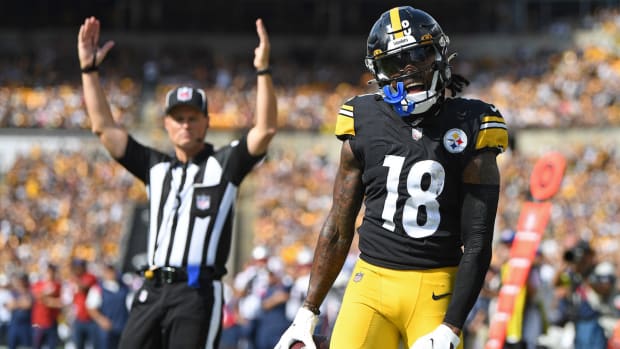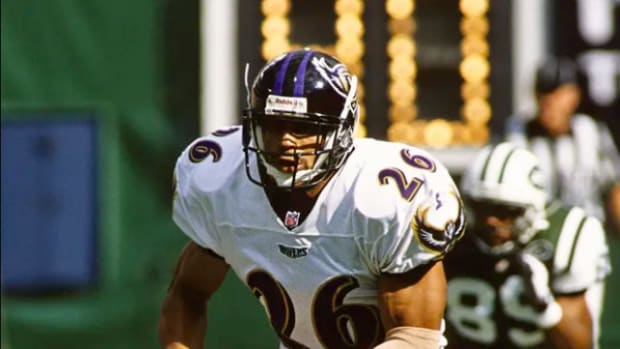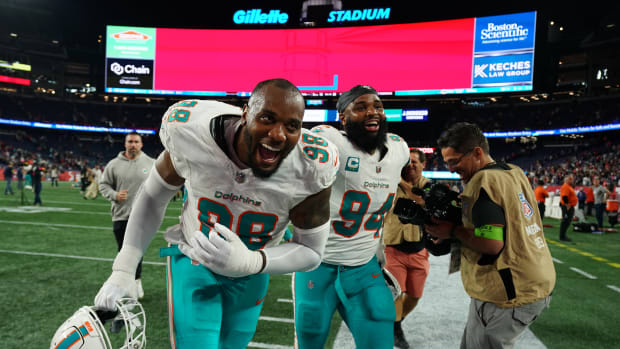Antonio Brown: Potential Legal Implications of Latest Developments
Update: The Patriots have released Antonio Brown.
The Antonio Brown saga has taken yet another bizarre turn, and it is one that could pose new legal and professional problems for the embattled Patriots wide receiver.
In an exclusive story for The MMQB, Robert Klemko reveals that an artist who claims Brown previously subjected her to unwanted sexual advances received a series of what she and her lawyer characterize as “intimidating and threatening” texts from Brown on Wednesday night.
In response to these texts, the artist’s attorney, Lisa Banks, sent a letter on Thursday to the NFL. In the letter, Banks demanded that the NFL take appropriate steps to stop Brown from harassing her client. The NFL responded to the letter late Thursday by arranging for a phone call with Banks and other attorneys who represent the artist.
The fact that the artist received these texts was not a random event. The texts were clearly sent in response to the artist’s account appearing in Klemko’s SI story, “There’s More History to Antonio Brown’s History,” which was posted on Monday. In that story, the artist told Klemko that Brown had hired her in 2017 to paint a portrait of Brown that would be placed on a mural in his Pittsburgh-area home. The artist recalled Brown walking behind her as she kneeled to paint. She says that Brown was completely naked other than holding a small towel over his genitals, and the artist interpreted this to be solicitous of sex. The artist says Brown ceased communication with her after she refused his advances, other than paying her for two days’ work.
In Klemko’s latest story, Banks, the artist’s lawyer, asserts that Brown texted her client and four other people in a group message on Wednesday night. A phone number belonging to Brown’s attorney, Darren Heitner, was one of the four listed. The messages were apparently sent by a phone with a number that the artist says Brown gave her in 2017 to contact him. Further, the texter’s statements and tone suggest Brown was the author.
The texter implied that the artist was lying about the 2017 encounter with Brown, with the goal of extorting him for cash. The texter also disparaged the artist as a “super broke girl.” In addition, the texter attached a screenshot of one of the artist’s Instagram posts in which the artist’s young children are shown, with the texter adding “she’s awful broke clearly.” The texter also directed an unidentified man named “Eric B” to “look up her background history.”
Banks insists in the letter that any suggestion that her client is out for money is false. The client, who does not wish to be identified, has neither contacted the police nor filed a civil complaint. She simply wants Brown to leave her alone.
Banks also says that the texts had a detrimental impact on the artist. “Our client,” the attorney notes, “is understandably frightened by these text messages, which are clearly intended to threaten and intimidate her.”
This could become a legal matter for Brown
If Brown is the texter, he could be investigated by Massachusetts law enforcement for criminal harassment. Massachusetts General Laws Chapter 265, section 43A, makes it a crime to intentionally terrorize other persons. Use of electronic communications to conduct the harassment is covered by this law, too. A person convicted of criminal harassment faces a possible jail sentence of up to two-and-a-half years.
Criminal harassment would likely be challenging to prove in this situation. This law requires a “pattern” of intimidating conduct that takes place over a period of time. Unless Brown has texted the artist on other occasions or plans to text her again, it may be difficult to show a “pattern.”
Criminal harassment also requires that the texts “seriously alarm” the intended recipient and “would cause a reasonable person to suffer substantial emotional distress.” It appears the artist was seriously alarmed, particularly by the texter sending photos of the artist’s children. Encouraging another man to look into the artist’s background can also be seen as troubling.
Since the artist does not intend to identify herself, law enforcement might decline to investigate. However, Banks’s identifying herself as the artist’s attorney could lead to Banks receiving a phone call from law enforcement.
Also, although not a criminal statute, Massachusetts General Laws Chapter 214 protects a person’s right to privacy. To that point, it guarantees that “a person shall have a right against unreasonable, substantial or serious interference with his [or her] privacy.” A texter sending photos of the artist’s children would potentially run afoul of this law.
Goodell gains another reason to render Brown ineligible to play
Brown is already under investigation by the NFL for sexual assault claims contained in a federal lawsuit filed by Britney Taylor, who worked with Brown as a trainer. Taylor met with the NFL for reportedly 10 hours on Monday. Per the NFL conduct policy, Goodell only needs to find that Brown “may have” committed an act of violence to conclude that Brown warrants placement on the exempt list. If Brown is placed on the exempt list, he would continue to be paid his base pay but would be ineligible to play games or practice with his Patriots teammates.
Goodell could keep Brown on the list until the league completes its investigation. The investigation could lead Goodell to suspend Brown without pay, though Brown would have an opportunity to meet with NFL investigators to rebut Taylor’s account before being suspended.
Separately, the NFL will investigate whether Brown sent texts designed to intimidate the artist. Under the personal conduct policy, the league is authorized to punish players for harassment and “similar forms of intimidation.” Also, the NFL could judge an attempt by Brown to dissuade a potential witness to his wrongful conduct as itself incompatible with the personal conduct policy. To that end, the policy notes that “any person who directly or indirectly through others interferes in any manner with an investigation, including by retaliating or threatening to retaliate against a victim or witness, will face separate disciplinary action under this policy. Prohibited retaliation includes, but is not limited to: threats, intimidation, harassment, or any other adverse action threatened, expressly or impliedly, or taken against anyone who reports a violation or suspected violation of this Policy or who participates in an investigation of a complaint.”
At the same time, threats and other words have not induced Goodell to punish players. His punishments have consistently reflected physical actions or alleged actions by players; there is no record of Goodell sanctioning a player solely for a verbal or written communication. For example, the commissioner recently declined to punish Chiefs wide receiver Tyreek Hill despite hearing a recording of Hill warning his then-fiancée, Crystal Espinal, that she needed to be “terrified” of him. The context of Hill’s threat was especially disturbing since in 2015, Hill admitted in court to acts of violence against Espinal. At that time, he also pleaded guilty to domestic assault and battery charges.
Given that track record, perhaps Goodell will decline to sanction Brown, at least with respect to the texts. On the other hand, the Hill audio recording controversy occurred, and was resolved, during the recent offseason. Given that the Brown controversy has surfaced during the regular season, and given the relatively low threshold for Goodell to justify placing a placing a player on the exempt—a finding that a player “may have” posed a danger to the well-being of another person—Goodell might view placing Brown on the exempt list as an appropriate step.
Brown’s endorsement income could continue to tumble
Brown has lost at least two endorsement deals. The first occurred in recent weeks when Helmet manufacturer Xenith dropped him. On Thursday, it became known that Nike had also dropped Brown. For now, it appears that Brown still has deals with Facebook and Pepsi.
Major brands almost always include “morals clauses” in endorsement deals. These clauses authorize (though don’t require) the company to suspend or terminate an endorsement deal when the player attracts controversy that damages the athlete or company’s image with consumers or shareholders. A player need not be convicted for a crime, charged or even sued for a morals clause to kick in. The standard for a company to invoke a clause is typically permissive.
Some have wondered why Nike would cut ties with Brown whereas it continued its relationship with Juventus star Cristiano Ronaldo (who was accused of sexual assault) and Paris Saint-Germain star Neymar (also accused of sexual assault). A plausible explanation is that Nike viewed global stars like Ronaldo and Neymar as much more valuable to the company than Brown. While an NFL star, Brown has nowhere near the profile of elite soccer stars known to fans across the world. This assessment of the player’s profile is important since it goes to the value of the endorsement for the company.
Brown’s representatives can’t seem to control him
Lastly, Brown’s conduct almost certainly infuriates those who have professional duties to advocate for his interest. If Brown has been texting the artist, it would reveal very poor judgment and a lack of discipline. The texts are permanent electronic records whose existence can’t be denied. While an attorney or agent can’t “control” what an adult client wishes to do, the failure of those paid to look out for Brown is stunning in its own light.
Michael McCann is SI’s Legal Analyst. He is also an attorney and Director of the Sports and Entertainment Law Institute at the University of New Hampshire Franklin Pierce School of Law.




































